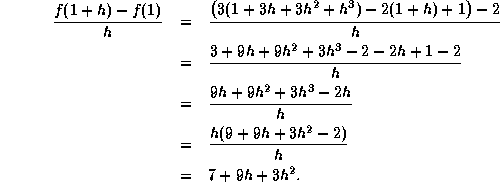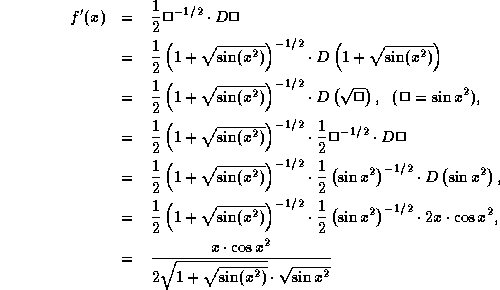![]()
Solution From the Binomial Theorem we know that ![]() . Next, we have
. Next, we have ![]() or, since f(1) = 3-2+1 = 2, we have for
or, since f(1) = 3-2+1 = 2, we have for ![]() ,
,

It follows that
![]()
Remark: As a check note that ![]() by the Power Rule.
by the Power Rule.
- [5]a)
- Let
 Find the derivative of f, i.e.,
Find the derivative of f, i.e.,  , using any method whatsoever.
, using any method whatsoever.
- [5]b)
- Evaluate
 .
.

At x=0 we have an indeterminate form, 0/0, so we must rewrite the expression in order to evaluate the two-sided derivative as an ordinary limit. Note that
![]()
for x>0. Using this we see that the right-derivative of f at x=0 is given by

The same argument can be used to show that
![]()
if x < 0 since ![]() , in this case. So,
, in this case. So,

Since the left and right-derivatives are not equal at x=0, it follows that ![]() DOES NOT EXIST.
DOES NOT EXIST.
- [5]a)
- A function y = f(x) is defined implicitly by the relation

Find the equation of the tangent line to the graph of y = f(x) at the point
 .
.
- [5]b)
- Calculate
 at the point
at the point  .
.
Solution y is given implicitly. So, the slope of the required tangent line is given by ![]() where
where ![]() is given by
is given by
![]()
Solving for ![]() , we get
, we get
![]()
Thus, ![]() .
It follows that the tangent line looks like y-0 = 0(x-1) = 0. So y=0 (or the x-axis) is the equation of the tangent line.
.
It follows that the tangent line looks like y-0 = 0(x-1) = 0. So y=0 (or the x-axis) is the equation of the tangent line.
In order to evaluate ![]() at the point
at the point ![]() we know that
we know that
![]()
At x=1, y=0 we get that ![]() .
.
- [5] a)
-
 ,
,
- [5] b)
-

Solution a) ![]() ,
,
b) ![]()
- [5] a)
-
 ,
,
- [5] b)
-
 .
.
Solution a) ![]() , since
, since ![]() as
as ![]() . On the other hand,
. On the other hand, ![]() as
as ![]() . So their product must approach
. So their product must approach ![]() .
.
Alternately,

b) We use the identity ![]() with
with ![]() . Then,
. Then,

But ![]() as
as ![]() . Furthermore
. Furthermore ![]() as
as ![]() and so
and so

On the other hand,

It follows that the required limit DOES NOT EXIST.
Let's assume that a planetary body is orbiting the sun (which is assumed to be very close to the origin) in a fixed almost circular orbit given by
![]()
Let's say that an asteroid is approaching the sun in an orbit whose equation is given by
![]()
Use Newton's method to find the two expected points of crossing of these two orbits, i.e., the two possible collision points, to three significant digits.